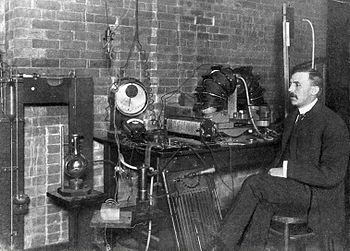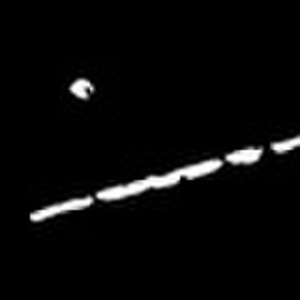Artificial nuclear reaction and discovery of Proton

Between 1917 and 1919 Rutherford conducted many experiments by bombarding nitrogen gas with alpha particles. These experiments indicated that penetrating radiation was emitted that Rutherford hypothesised might be the nucleus of a hydrogen atom. It was with these first experiments that Rutherford and his team became the first in history to initiate an artificial nuclear reaction.
In 1917 (in experiments reported in 1919), Rutherford proved that the hydrogen nucleus is present in other nuclei, a result usually described as the discovery of protons. Rutherford had earlier learned to produce hydrogen nuclei as a type of radiation produced as a product of the impact of alpha particles on nitrogen gas, and recognize them by their unique penetration signature in air and their appearance in scintillation detectors. These experiments were begun when Rutherford had noticed that, when alpha particles were shot into air (mostly nitrogen), his scintillation detectors showed the signatures of typical hydrogen nuclei as a product. After experimentation Rutherford traced the reaction to the nitrogen in air, and found that when alphas were produced into pure nitrogen gas, the effect was larger. Rutherford determined that this hydrogen could have come only from the nitrogen, and therefore nitrogen must contain hydrogen nuclei. One hydrogen nucleus was being knocked off by the impact of the alpha particle, producing oxygen-17 in the process. This was the first reported nuclear reaction, 14N + α → 17O + p. (This reaction would later be observed happening directly in a cloud chamber in 1925).


Rutherford knew hydrogen to be the simplest and lightest element and that hydrogen was the building block of all elements. Discovery that the hydrogen nucleus is present in all other nuclei as an elementary particle led Rutherford to give the hydrogen nucleus a special name as a particle, since he suspected that hydrogen, the lightest element, contained only one of these particles. He named this new fundamental building block of the nucleus the proton for the Greek word for "first", πρῶτον. The first nuclear reaction initiated by a human and the discovery of the proton are big steps in themselves, but from these reactions you can also infer the sizes of nuclei.
Later captured rare cloud chamber images that revealed the full detail of what was happening. The photographs showed some of the alpha particles were absorbed by the nitrogen nuclei. This process led to excess energy in the nitrogen nuclei, resulting in an oxygen atom and a hydrogen nucleus being emitted.It also led to the development of nuclear accelerators - so that you could induce all sorts of different nuclear reactions. This discovery, and the earlier work done by Rutherford that established the existence of an atomic nucleus itself, essentially established the field of nuclear physics.
Detection of particles with a cloud chamber
REFERENCES
University of Manchester. Available in: https://www.manchester.ac.uk/discover/news/rutherfords-legacy--the-birth-of-nuclear-physics-in-manchester/. Access in: 04/09/2018.
Wikipedia. Available in: https://en.wikipedia.org/wiki/Proton. Access in: 04/09/2018.


























0 comments
Sign in or create a free account